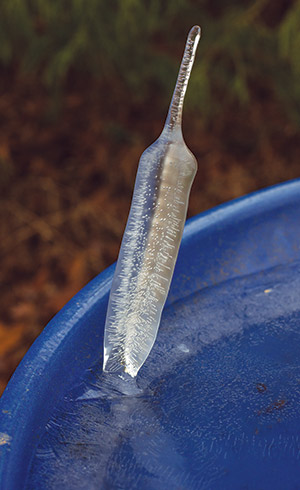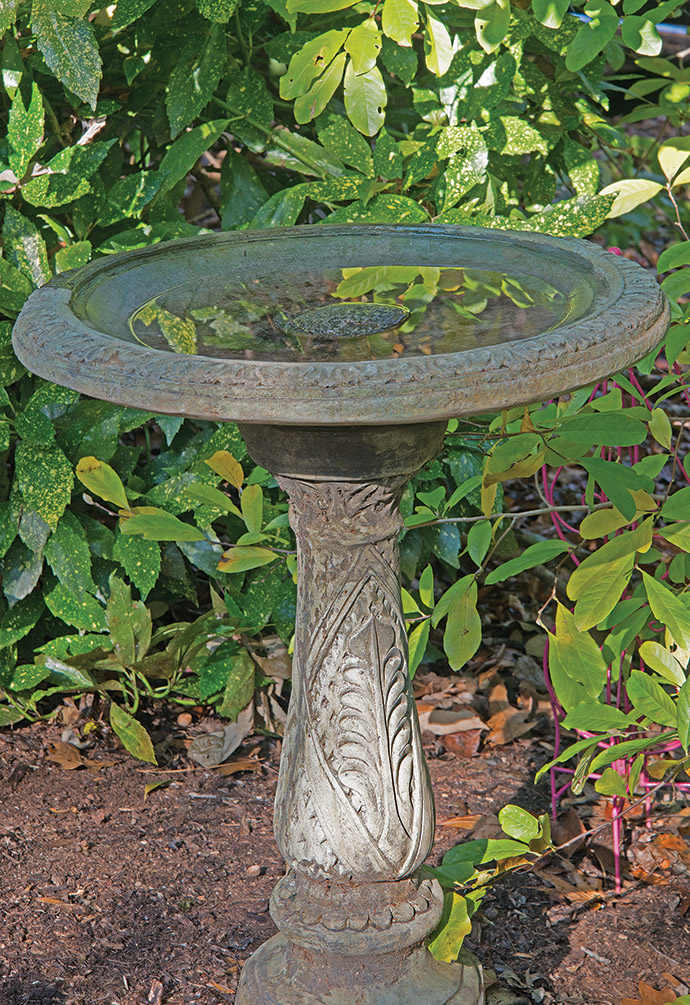Birdbaths are welcomed additions to any garden scheme because they provide fixed points of visual interest in seasonally changing landscapes, and of course, because they are desirable watering holes for many feathered friends.
So whether you have one or are thinking about adding such a handy hardscape feature to your garden this year, here are a few pointers for a better birdbath:
- While a heavy cement or stone birdbath provides increased stability compared to those made of lightweight resin or plastic, it is more susceptible to breaking if water constantly freezes and thaws in the bowl during the winter. A good way to prevent ice formation in it, and still provide a reliable refreshment station for birds in the winter, is to set a shallow plastic container in the birdbath. Make sure the container’s lip overlaps the sides of the birdbath in order to catch and hold water.
- If the water in a cement or stone birdbath does freeze, the best way to thaw it is to set a pan of hot water on the ice. Do not pour the heated water onto the ice — it could crack the bowl. For the same reason, don’t hammer ice out of a birdbath.
- A dark colored birdbath in a sunny location will freeze over less often, but it could also be uncomfortably hot in the summer. A solution to this is to find a site that is shaded by deciduous trees or shrubs during the growing season but exposed to the warming sun through bare branches in winter.
- Because it is bowl-shaped, a birdbath usually has a deep section in the middle that could be dangerous to fledglings and small birds. Set a flat rock in the center that sticks slightly above the water surface for a safe perch.
- Besides being attracted to it for drinks of water, birds use a birdbath for the obvious — to take baths. With this in mind, consider locating it close to shrubs or short trees with strong limbs so soaked birds will only have short flights to a safe place in order to preen and dry.
- No matter the weather, always keep fresh water in the birdbath by changing it at least once a week. Sure, this is a constant chore, but it will result in plenty of repeat visits from your winged garden friends.

An ice spike can show up in your bird bath when conditions are right.
Not only will birds be seen in your birdbath this winter, but if conditions are just right, you might also witness a phenomenon known as an ice spike.
This happens when a shallow container of water, such as a birdbath, is quickly frozen. Water freezes from the top down, but since this icing can be uneven, a small hole on the surface is sometimes left. As the water continues to solidify, it expands. Some liquid could be pushed up through the hole, which in very cold weather then begins to build a hollow tube of ice that rises at an angle.
Eventually the hole freezes over, completing the ice spike and resulting in a Kodak moment.
To Do in the Garden
February
- Winter dry spells can be just as harmful to evergreen trees and shrubs as summer droughts, so water them if the rains don’t come for extended periods of time and maintain a 2- to 3-inch mulch around new plantings. Also, applying an anti-transpirant such as WiltPruf will help reduce moisture loss through evergreen leaves.
- Established hybrid tea and bush roses can be pruned now. Climbing roses that are repeat bloomers can be lightly pruned as well, but if your climber is one that only flowers once in the growing season, wait until after the last of its blossoms have faded in the spring.
- Ornamental grasses such as northern sea oats, miscanthus, pampas grass and pennisetum have done their part in adding interest to the winter garden, but now is the time to get these lovelies ready for the spring growing season by pruning them back to 6 to 8 inches above the ground. Any seed heads still in good condition can be brought inside for use in dried arrangements. Low-growing grasses such as liriope and mondo grass will also benefit from being cut back this month. In addition, now is a good time to divide ornamental grass clumps and replant the divisions.
- Any spent camellia blooms that have fallen to the ground need to be raked up and tossed in the trash to discourage camellia petal blight, a soil-borne disease that turns the petals of future flowers an ugly brown.
- The middle of this month will be a good time to wake up any yard festooned with fescue grass by giving it a nutrient boost of lawn fertilizer at a rate of one pound of nitrogen per 1,000 square feet.
- Is creating a stone walk one of your late winter landscape projects? If you are using sand instead of mortar for setting the stones, include one extra step: Before laying any stones and sand down, add a sheet of plastic weed block to the pathway to help cut down on unwanted plants coming up between the stones. Ditto for new paths built with bricks.







